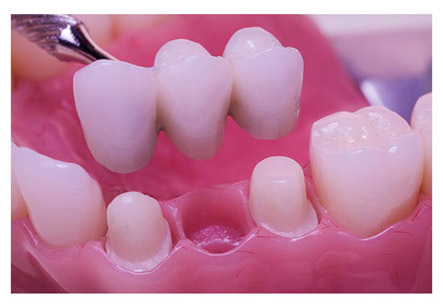Porcelain Bridge
Introduction
A porcelain dental bridge is a dental technique of restoration for replacement of missing tooth. It adheres to contiguous teeth or other implants in a permanent manner. They prevent dental problems like decay of tooth, speech disturbances and shifting teeth.
Purpose of Porcelain Bridge:
The most essential purpose of fixing a dental bridge is for preventing the contiguous teeth from shifting in a place created by missing teeth. This shifting also causes change of bite, sore jaws and problems in the temporomandibular joint. Missing teeth also compromise dental and oral hygiene causing tooth decay and various gum diseases.
Porcelain is very durable and looks natural in appearance as compared to ceramic or metal bridges. Iran offers a superior Dental treatments that is world best quality. For patients from the USA, and Europe for example, the savings can be 60% or more

Two types of bridges are available in porcelain:
1. All porcelain- these are very translucent bridges difficult to distinguish from your natural teeth.
2. Porcelain bonded to a metal core- in this type, a dark line is visible just above the gumline. This line denotes the presence of dark blue metal core in the porcelain. Without the metal core, there is no dark line where the bridge meets the gums.
Structure of bridge:
A false tooth, also called as a pontic, is fused in between two crowns made up of porcelain material and the gap left by a missing tooth is filled. These two crowns hold onto the false tooth to the adjacent teeth on either side. This is known as a fixed bridge. By using this procedure, one or more missing teeth can be replaced. But for this procedure, the support teeth must be built up first in case if they are broken or decayed. Fixed bridges cannot be taken out of mouth like the removable partial dentures.
Procedure:
The dentist first prepares the teeth on either side of the defect left by a missing tooth. A mild anesthetic is injected to numb the area. Then the cosmetic dentist makes enough space between the teeth on either side so as to accommodate the thickness of the crown. If these teeth have fillings, it can be used as a foundation for the crown.
The dentist makes an impression, from which the bridge, false tooth and crowns are made in a dental laboratory. Until the next visit, patient is made to wear a temporary bridge. This temporary bridge protects the teeth and gums till the permanent bridge is made. Or else, a Flipper appliance is used in the place of missing tooth till the permanent bridge is placed. A Flipper is a false tooth attached via either a wire or a plastic piece to the roof of the mouth awaiting the permanent bridge.
On the second visit, the temporary bridge is removed and new permanent bridge is fitted and checked and adjusted for any bite problems. If none, the new bridge is cemented to the teeth permanently.
Advantages of dental bridges:
1. Porcelain is very durable and looks natural in appearance as compared to ceramic or metal bridges.
2. Generally only two visits are required for this procedure.
3. Porcelain bridges can last for as many as ten years or more if good oral hygiene is maintained.
Disadvantages of having a porcelain bridge:
1. The teeth can become mildly sensitive to extreme temperatures for a few weeks after the bridge placement
2. If proper oral hygiene is not maintained, the growth of bacteria formed from food acids on teeth and gums can become infected.
3. Patient feels presence of something alien inside the mouth for several days.
4. The porcelain is very expensive and many patients cannot afford the treatment.
Care of this bridge:
All areas around the bridge must be flossed and brushed regularly. Sometimes, it is not possible to floss between the replaced tooth and the attached crowns because it is made as a one piece. For this issue, a special type of floss is available which goes under the replacement and keeps the bridge as well as gums.